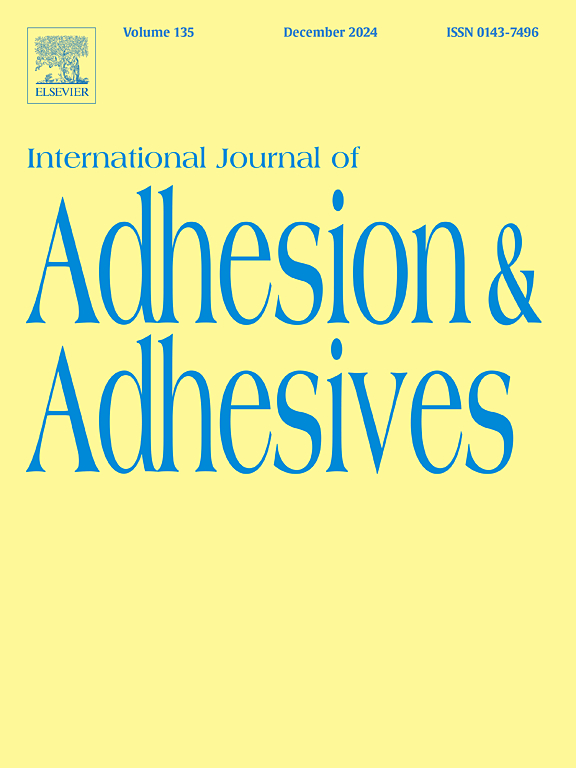Adhesion strength of 3D printed PLA on knitted fabrics and optimizing for improved performance
IF 3.5
3区 材料科学
Q2 ENGINEERING, CHEMICAL
International Journal of Adhesion and Adhesives
Pub Date : 2025-02-13
DOI:10.1016/j.ijadhadh.2025.103975
引用次数: 0
Abstract
The application fields of 3D printed textile related products depend on the adhesion of the imprint polymers with textiles. Adhesion is the tendency of unlike surfaces to cling one another due to the intermolecular and interatomic interaction of the two surfaces. In this study, effect of textile structure on adhesion strength from a physical form-locking connection and optimization of process parameters for improved adhesion strength of 3D prints on textiles are investigated. The process parameters investigated in this research are extruder nozzle temperature, printing speed and layer thickness of every layup. The fabric structures include knitted fabrics of 1∗1rib, stripe jacquard and different number and directions of tuck knitted fabrics. The prints were produced from poly lactic acid (PLA) using Flash Forge Guider II 3D printer on knitted fabrics. The different printed samples were subjected to a 180° peel test according to the DIN EN ISO 8510-2 test standard of flexible bonded to rigid test specimen assembly for the full detachment of the prints from the fabric. As seen from the result, the fabric structures and the process parameters of 3D prints investigated in this research significantly influences the adhesion force. The further results revealed that the low temperature, high running speed and high thickness of the print layers limits the penetration, passage and attachment or adhesion of melt PLA through the fabric which gives low adhesion strength between the print polymer and the fabric. The surface appearance of the different loop formation of the knitted fabrics influences the adhesion strength of 3D prints on textile. The microscopic analysis revealed that the back of the detached 3D prints from the knitted fabrics contains much more fibers still attached because of the high adhesion strength from rough surface of knitted structures, high temperature, low printing speed and low layer thickness of the print.
3D打印PLA在针织物上的粘附强度及其性能优化
3D打印纺织品相关产品的应用领域依赖于印染聚合物与纺织品的粘附性。粘附是由于两个表面的分子间和原子间相互作用,不同的表面相互粘附的趋势。在本研究中,研究了纺织品结构对物理锁形连接的粘接强度的影响,以及优化工艺参数以提高3D打印在纺织品上的粘接强度。本文研究的工艺参数为挤出机喷嘴温度、打印速度和每层厚度。织物结构包括1 * 1罗纹针织物、条纹提花织物和不同数量、不同方向的提花针织物。利用Flash Forge Guider II 3D打印机在针织物上打印出聚乳酸(PLA)。根据DIN EN ISO 8510-2测试标准,对不同的印花样品进行180°剥离测试,测试标准是柔性粘合到刚性试样组装,以使印花完全脱离织物。从结果可以看出,本研究所研究的3D打印材料的织物结构和工艺参数对粘附力有显著影响。进一步的结果表明,打印层的低温、高运行速度和高厚度限制了熔融PLA通过织物的渗透、通过和附着或粘附,导致打印聚合物与织物之间的粘附强度较低。针织物不同环型的表面形貌影响着3D打印在纺织品上的附着强度。显微分析表明,从针织织物上分离出来的3D打印件的背面,由于针织结构粗糙表面的附着强度高、温度高、打印速度慢、打印层厚度小等原因,仍然附着着更多的纤维。
本文章由计算机程序翻译,如有差异,请以英文原文为准。
求助全文
约1分钟内获得全文
求助全文
来源期刊

International Journal of Adhesion and Adhesives
工程技术-材料科学:综合
CiteScore
6.90
自引率
8.80%
发文量
200
审稿时长
8.3 months
期刊介绍:
The International Journal of Adhesion and Adhesives draws together the many aspects of the science and technology of adhesive materials, from fundamental research and development work to industrial applications. Subject areas covered include: interfacial interactions, surface chemistry, methods of testing, accumulation of test data on physical and mechanical properties, environmental effects, new adhesive materials, sealants, design of bonded joints, and manufacturing technology.
 求助内容:
求助内容: 应助结果提醒方式:
应助结果提醒方式:


